by Food+City | Dec 16, 2012 | Food Tracks Blog, Stories
In November’s Meatpaper: Issue 19, you’ll find this essay, a short piece inspired by a trip I took with my dear friend, Linda.

Early Californians lusted after gold, traveling up and over the chiseled granite Sierra Nevada on their way to the Gold Country. Two summers ago, a dear friend and I had high prospects of climbing Mt. Whitney, repeating the trek we had previously taken over thirty years ago. We hove up and over the majestic peak before returning to our encampment at the base of the mountain. Slithering through the camp was a stream teaming with California’s native freshwater fish, the Golden Trout. After a few brief, but apparently effective demonstrations of fly-fishing technique by the camp cook, I flicked my fly rod over the water’s surface and returned to camp beaming with three glistening Golden Trout. Nothing – really nothing – delivers a rush like that of freshly caught Golden Trout cooked over a campfire. Those early California gold seekers held their pans in anticipation of a few flakes of gold; I held my pan satiated with my three nuggets of golden treasures.
As published in Meatpaper, Issue 19, Fall 2012
by Food+City | Dec 1, 2012 | Food Tracks Blog, Stories
Over fifteen years ago, Rob Savenor, owner of Boston’s Beacon Hill grocery store, sat with me on his loading dock to discuss how much he’d pay me for my leg of lamb. I had traveled to Boston from my farm in Maine with a cooler full of “heritage” meat. “Heritage” is a term used by foodies, even then, to describe meat from a few remaining breeds raised by farmers centuries ago. Much like heirloom seeds, these animals are no longer commercially viable and so are left to conservationists, such as myself and a few others, who feel that they have both historic and culinary value. During the 1990s, convincing Ron of these values had taken persistence and he cautiously agreed to sell the meat to his customers.
The scene on the loading dock occurred more frequently over the following months, and soon our heritage lamb and then pork appeared on menus of high-end restaurants in Boston and New York City. Chefs began to see the value of pasture-raised, artisanal, and niche products could enhance their menus, endearing their restaurants to customers who began to ask about the origins of their food. Now, chefs everywhere tout their greenness, sustainable practices, and local provenance, not to mention their good fortune in acquiring a few heritage meats for their menus.
Public awareness, the food industry, investors, and the government are clambering for a seat at the table in the food space. Food is no longer of interest just to foodies and molecular gastronomists such as Nathan Myhrvold. McDonald’s wants to be in the game along with food activists and entrepreneurs. Fast food is no longer content to be fast; it now want to be casual, local, green, and able to tap into their alert and voracious market. This means a food bubble is about to arrive.
A sure sign is the interest expressed by first-rate venture capitalists who have begun to invest their funds in food startups. Another is the success of crowd-funded ventures for food products, circumventing the traditional round of angel investing. After years of Slow Food, Farm, Inc., and the unabashed meteoric growth of Whole Foods, the flow of funds to food startups is about to begin.
So what does this mean for our food and for investors? Speculative bubbles are tools for the innovator. Capital comes out of the woodwork, hoping to cash in, and eventually out. The challenge then becomes one of mitigating loses.
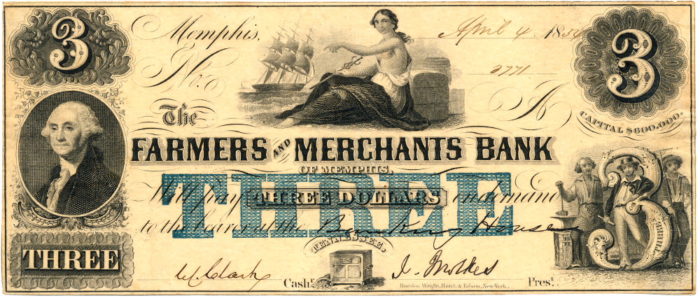
Bubbles in other industries show us that when the bubble fizzles, the food industry will have been benefitted by the competition among the thousands of entrepreneurs and ideas that will flood the market. And yes, investors could brace themselves for the seductive quality of food ventures. New restaurants and the possibility of ending hunger and of eliminating obesity are compelling arguments for investing in a new enterprise.
The bubble may be an opportunity to move past the political and cultural arguments around food that tend to sidetrack reason and sabotage efforts to innovate. With an infusion of capital and a pinch of social investing, our food system may benefit from innovation that can create scalable solutions while offering a range of options, including big and small farms, local and global providers, and a pragmatic utilization of technology. Let’s get ready for the bubble.
Dr. Robyn Metcalfe, University of Texas at Austin, Director of The Food Lab, Food Historian, and Research Fellow, Center for Sustainable Development, School of Architecture.
by Food+City | Nov 18, 2012 | Food Tracks Blog, Stories
Eating out of the box, in the box, and from the box is a culinary activity that is drawing new and fortuitous attention. Eating OUT of the box is the challenge issued by food nutritionists and foodies who want consumers to resist the temptation to buy processed, ready-made meals that are sold in microwaveable boxes. Eating IN the box is an activity that takes place in large, industrial buildings owned by such behemoths as Wal-Mart and Costco. Those “big box” enterprises are often castigated for their inhumane, boxy shape and are eschewed by those who resist bigness, not to mention boxes. And last, eating FROM the box means eating items from boxes that arrive on your doorstep through the postal service or other carriers. These boxes are fast becoming the new metaphor of our food system.
The relationship between food and boxes seems shallow; but look deeper and you observe that boxes are the repositories of education, food retailing, and healthier diets. How so? For decades, the Community Supported Agriculture (CSA) movement offered its subscribers monthly deliveries chock full of a farm’s monthly produce. You bought a share in a farm’s produce, you received a box of a farmer-curated harvest. Now, subscriptions to monthly deliveries of food are taking new forms as entrepreneurs see a potential for the box.
Urban farm-to-table services are delivering curated food to city dwellers by subscription. Companies like Austin’s Greenling, Farm-to-Table, and Farmhouse Delivery gather up produce from local farmers and bring them to your door in a recyclable box. Web-based services offer monthly-curated boxes that include such artisanal foods as handmade chocolates and herb-encrusted roasted almonds. Consumers learn about new products and local businesses become part of a local brand as they get a chance to provide samples to their target audiences. Examples of these companies include Joyus, Zingerman’s, Tasterie, Love with Food, and New York Mouth. These new companies bring connoisseurship to the CSA box. The curated food box, valued by its association with sophisticated taste, adds value for customers by leveraging the culinary intelligence of an individual who hand-picks the box contents. Called “discovery commerce”, the curated box is the new food app.
This week Wal-Mart made a appearance in this emerging market with its own curated food box. The creation of Wal-Mart Labs, where the company innovates and creates new products and services, the food box moves Wal-Mart into a market usually filled with companies that align themselves with the organic and Slow Food movements. The new box evoked both surprise and consternation by food activists who see Wal-Mart as the symbol of what’s wrong with our food system. But perhaps this is a sign that improvements are coming from the top down, not only from grassroots communities.
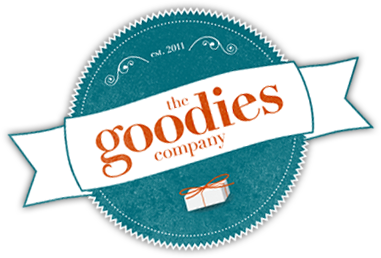
Wal-Mart’s curated box is available through a new service called The Goodie Company. If the new venture does well, Wal-Mart could expose their customers to new and healthier ways of eating at lower prices.
Could this be a win for consumers? While Wal-Mart is off-limits for most foodies, for either quality, political, or ethical reasons, shouldn’t we celebrate innovation and opportunities for consumers to buy better food from local businesses at lower prices? Wal-Mart may be bringing scale to the concept of small and precious. Perhaps this is a model worth watching, either from the box, in the box, or by buying the box.
P.S. I forgot to mention a new Austin box, Coterie Market…..not up and running yet, though.
by Food+City | Nov 12, 2012 | Food Tracks Blog, Stories
University of Texas: 33
Iowa State University 7
Fans 3
I take pity on anyone who asks me to join them for a meal. It’s nearly impossible for me to suspend my intense occupation with food and sometimes, which must at times be almost unbearable, if not embarrassing. My hosts at this weekend’s football game put up with my challenge to find healthy food at the stadium. At University of Texas at Austin Darrel K. Royal Stadium that weekend, the Longhorn football team emerged the victor over its rival, Iowa State University. But the fans lost when it came to eating a healthy meal.
If, while spending four hours watching the game, you become hungry, you are provided traditional fare for game day: popcorn, corn dogs, hot dogs, hamburgers, pizza, and French fries. But what if you’ve begun to care more about your diet, spend time at farmers markets, and hear how your food choices will either extend your life or lead to obesity or diabetes?
You prowl the stadium for a few green leaves that could resemble a salad or at least one yogurt or fruit smoothie stand. Alas, you will search the multiple floors of the stadium with little to show for your good intentions. Not only are hot dogs, pizza, and BBQ on fluffy white rolls ubiquitous, they are expensive. The standard price for a hot dog is $4 and a 44-ounce drink is $6. Forty-four ounce drink? What would Bloomburg do?
We decided to see if we could turn up some green lettuce or a tofu wrap. And we succeeded. One food truck, hunkered down on the visitor side of the stadium offered tofu tacos. And in the food court outside the end zone, Starbucks, a sushi stand, a local hamburger purveyor, and Quiznos offered their “game day menu,” which included at least a variation of their signature dishes The lines were shorter at these stands and the servers were delighted when even a short queue appeared. A lonely ice cream stand stood in the corner of the end zone area, offering scoops of locally made ice cream with flavors such as Madagascar vanilla, double dark chocolate and, oops, cotton candy.
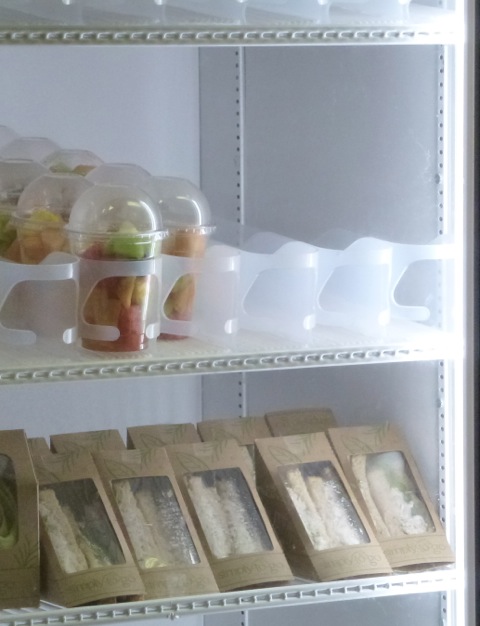
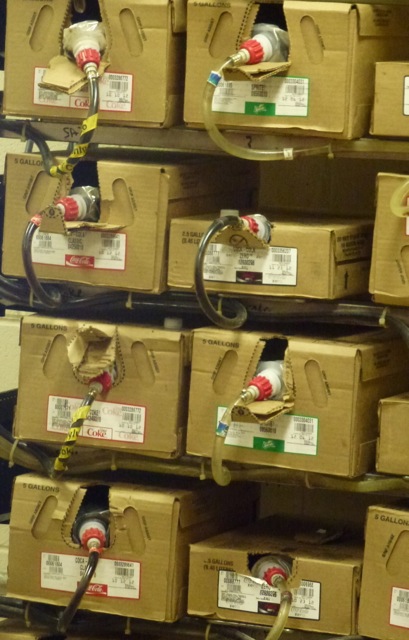
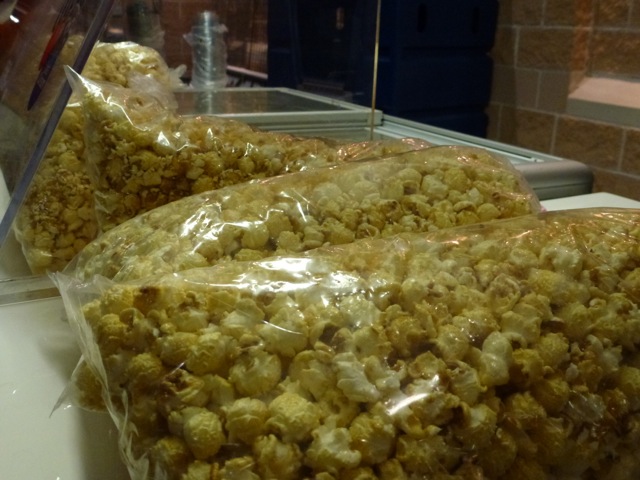
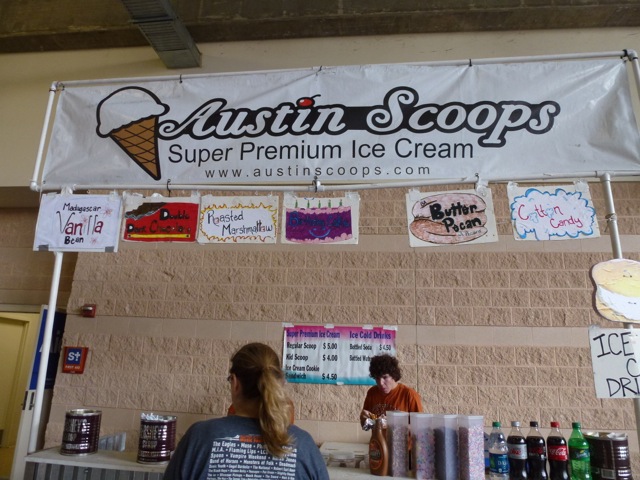
Feeling sorry for the sushi guys, I purchased two California rolls for my husband and I (Total=$20). As I carried the sushi through the stadium on my way back to our seats, three members of the stadium security staff stopped to ask where I got the sushi, assuming that I must have brought in from outside the stadium. (The stadium regulations state that no food or beverages purchased outside can be brought into the stadium.) The security guards quickly remembered the sushi vendor but after the third encounter, it was apparent that the sushi had become a security risk.
No wonder. A cursory look at what others were eating made it clear that French fries were the standard fare. The good news is that the stadium food managers made an effort to provide a few healthy options; the not so good news is that the spectators that day really want the dogs, burgers, and fries. So let’s not say that the fans lose when it comes to food options as at Darrell K. Royal Stadium; lets just say that they scored three, representing at least the sushi guys, Quiznos, and a hidden cooler behind one pretzel vendor stand that had some lonely whole wheat bread sandwiches. And not to pile on, but the only ones getting any exercise that day, were the guys on the field.
by Food+City | Nov 3, 2012 | Food Tracks Blog, Stories
Michael Pollan recently spoke to a packed house here in Austin, Texas. The audience included members of “The Food Movement,” as Pollan called them, as well as his many loyal readers. His message was simple, direct, and eloquent. Eat simply, know where your food comes from and ….. beware of capitalism.
Six years ago, I attended a talk by Mr. Pollan in a small Cambridge, MA bookstore when his now award-winning book came out, The Omnivore’s Dilemma. The audience was about a tenth of the size of last night’s crowd and much less enthralled. His talk was just one in a series of authors who stopped by to promote their latest books. Pollan was impressive from the standpoint that he was as articulate in person as he was in his book and he seemed reasonable. Reasonableness is not always a quality shared by those in “The Food Movement” (in which I’ve held sporatic memberships).

Pollan follows the method championed by George Plimpton of The Paris Review: Get out in the field, literally, and experience your topic. His reasonableness arrives through his on-the-ground experience. One of his most famous was his travels with a steer who eventually became his hamburger. Pretty gutsy.
For the past six years, Pollan has convinced thousands of readers of the importance of good food and of our broken food system. But when asked by the articulate Addie Broyles, his interviewer for the evening last night, for his ideas about the future, he seemed circumspect. His early prescient call for alertness about the food we eat could turn now to some unreasonable leadership, the kind that crosses the boundaries between agribusinesses and local farmers. How to create that edgy leadership without losing his following … is the real dilemma.
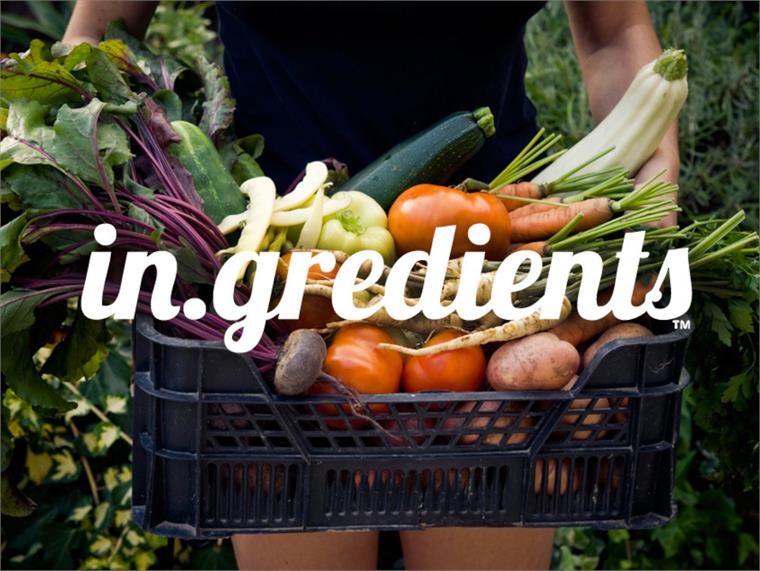
by Food+City | Oct 28, 2012 | Food Tracks Blog, Stories
In.gredients, a new Austin food startup, promises to change the way we shop for food. When the company’s founders announced its plan to eliminate wasteful packaging, foodies and the media celebrated the merits of the new enterprise, hopeful that in.gredients customers would arrive at the new store with reusable and recycled bags and containers. The founders announced they would provide package-free food that would begin the march towards a zero-waste food system. Major media outlets such as The New York Times and CNN piled on with accolades for the company, long before the business opened its doors.
Now that the doors are wide open, the company’s big vision seems smaller than advertised. While the beautiful repurposed Austin cottage sells some of Austin’s finest artisanal and local food (bread from Easy Tiger, quiches from Cake & Spoon), the building only contains three rows of bulk bins, hardly half of the bulk bin space in Central Market. After purchasing half a dozen eggs (egg cartons provided) and some peanut butter (plastic tubs provide), I left the store wishing that the founders would begin negotiations with one of the empty warehouses on the fringes of East Austin. In.gredients should return to and embrace that original mission to think bigger and bolder.
If you want to disrupt the food system by building a zero-waste outlet, you need lots of bulk, in the sort of space occupied by Home Depot or Costo. Maybe a package-less Costco, filled with local, healthy bulk food items. Disruptions require boldness, audacity, and the willingness to go all-in with an idea that could overwhelm the package-intensive weak areas of our food system.
The founders of in.gredients are probably not in negotiations with the owners of a large warehouse but they could be inspired by some early examples of bulk food storage that defy the unattractive optics of industrial warehouses, such as the King’s Cross grain depot in London during the 19th century.
London’s grain supply entered the City through rail depots positioned around the periphery, bringing food in bulk from all directions outside London. The train from northern England delivered grain into the King’s Cross rail terminus where Lewis Cubitt built a wheat storage facility in 1851-2. Trains rumbled down from Lincolnshire after the annual wheat harvest, supplied the grain depot at the King’s Cross rail terminus, and departed for London bakeries aboard urban canal boats. Up to 60,000 sacks of grain moved from rail to canal and to the roads in London, lifted up and moved from one conveyance to another by an impressive hydraulic lifting system, a modern innovation of the Victorian period. Acting like our modern “food hubs,” these 19th century bulk food storage buildings appeared in other European cities.

(You can learn more about granaries here: http://www.buildingconservation.com/articles/granaries/granaries.htm) Seems that the founders of in.gredients could find inspiring structures from these early granaries. Founders, Lane brothers, Christian, Joseph, Patrick, and Brian Nunnery, Christopher Pepe.
UPDATE: As of 2018, in.gredients is permanently closed. Read more about the closing here: https://www.austinchronicle.com/daily/food/2018-04-25/damn-it-all-in-gredients-is-closing/









